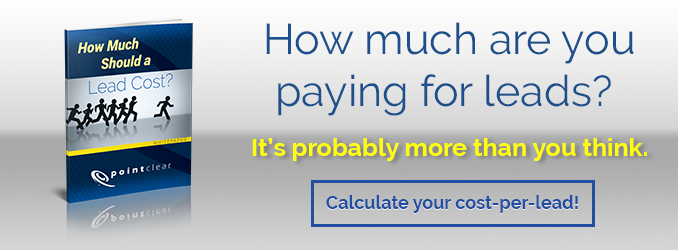
Even the most ambitious and efficient companies with highly competitive offerings, like GE or Boeing, don’t close 100% of their deals. These companies have a very high demand for their products and services, but they still need strong lead generation and qualification processes. It is unrealistic, even for the aforementioned companies, to think that sales can close every opportunity they receive. These companies are successful because of their established roles, processes, and responsibilities for their marketing and sales departments.
Effectively turning sales leads into revenue means each department responsible for revenue (Marketing and Sales) has clear responsibilities. Marketing’s responsibility is to work with sales to identify the challenges or pain points of their target audience and create tailored content to speak to those challenges. By doing this effectively, marketing can greatly increase their revenue contribution and enhance sales’ ability to close. Post lead follow-up, sales should give marketing feedback on what content or offers worked, and what didn’t. This collaboration is essential for companies that want to perfect their lead generation strategies.
Find the PainThe lead development process typically starts one of two ways:
In the first instance, a suitable prospect may indicate a pain point that designates a need in your company, products, or expertise. Asking them what challenges they experience in their role is a great way to discover more about their pain points.
Eventually, the pain point will be an opportunity to transition into a discussion around how you can help alleviate those challenges. For example, companies always want to make more money. If you can present a reasonable, achievable, and helpful solution to assist that prospect to increase their revenue or decrease their spending, you’ll bet they will be listening.
In the second instance, pain points aren’t clearly discussed, but they can be deduced with accuracy from a conversation with a prospect. For example, if a prospect tells you that they are concerned about confidential business information falling into the wrong hands, you can quickly calculate that person’s need for counter cyber defense technology. Once you raise awareness in that prospect, your solution will be the first that comes to mind.
The importance of pain points in prospecting is uncovering the area where you need to focus in order to create an interest in your business on the behalf of the prospect. Find the pain point, and you’ll be able to understand what solution your prospect is looking for.
Qualify Your Lead
A good sales-ready lead is not just an email address with a pain point. Rather, it is one that meets agreed-upon qualifying criteria, and has been nurtured or developed to the point where it’s ready to be handed over to the sales team. A qualified lead is one that has been:
- Contacted several times already over various channels such as email, telephone, and direct mail
- Screened for a need in your product or service
- Found to have a pain point that your product or service can resolve
- Filtered for being a long-term or short-term prospect
Moreover, by using your CRM to your benefit and recording their company profile, contact history, project budgets and timelines, and any additional noteworthy details, you will see a boost in revenue. This process is important for many reasons, including that it:
- Filters raw leads to disqualify dead ends
- Gives potential clients time to warm up to you
- Provides you with valuable insight about the prospect’s pain points and pressing issues
- Allows salespeople to have awareness into how they can most effectively pitch solutions
Turn Your Lead into a Sale
Timing: Once a raw lead has been developed into a sales lead, turning it over to the sales team is the next step. Sales should then further the relationship and work strategically to close the deal. Studies suggest that about 50% of leads that have been qualified will result in a sale within one year. Is your prospect looking for a solution now, in a few months, or will they close the deal in a year? Uncovering this detail will help you prioritize a lead and refrain from “rushing” your prospect based upon their position in the sales cycle.
Preparation and personalization: Using the information collected by the prospector and inputted into the CRM, sales reps should be adequately prepared when speaking to sales-ready leads. When the sales reps make initial contact, they should be ready with a prepared consultation with detailed talking points.
Actionable solutions: Regardless of the product or service you provide, what matters to your possible customers is how your business can help them get results. Your sales reps may have well-prepared pitches and attractive product incentives, but if you don’t showcase how you can help your prospects generate positive outcomes; you will not make the sale. Make sure your solutions will provide actionable results for your client-to-be.
Not all sales leads are created equal. Regardless, make sure you have a lead generation strategy in place, and that you strictly adhere to it. Failure to do so will keep your business from growing, keep you from retaining your employees, and keep your company from being sustainable.
Topics: Sales Leads






